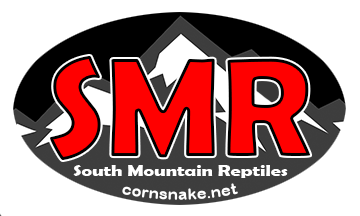
🥇 The Golden Rule: Only Feed Captive-Bred Rodents
For the health and safety of your corn snake, it is critical to feed only captive-bred rodents.
Parasite Risk: Wild rodents, lizards, and birds, or even captive-produced animals from unverified sources, can transmit internal parasites to your snake.
Toxin Transmission: Freezing does not eliminate toxins. If the food item has been in contact with any poisons, they will be transmitted to your snake.
Pathogen Survival: Some diseases and pathogens are not killed by standard residential freezing temperatures.
📏 Determining Prey Size for Your Corn Snake
Choosing the correct prey size is vital for healthy digestion and preventing regurgitation.
Prey Size Guideline: The rodent should be under twice the diameter of your snake’s mid-body girth. A good goal is a rodent that is approximately 1.5 times the snake's girth.
Digestion Temperature: This guideline is only valid if proper digesting temperatures (per your enclosure/CAGING setup) are consistently available to your snake.
Need an Alternative? If your corn snake refuses domestic rodents, immediately consult a professional snake breeder or a specialized corn snake care book for temporary feeding recommendations.
👶 Feeding Hatchling Corn Snakes
Age Range: Hatchlings (approximately one to 15 or 20 weeks old).
Prey: One-day old mouse pinkies (newborn mice).
Frequency: Once or twice weekly.
Overfeeding Risk: Hatchlings may seem hungry for more, but overfeeding can be dangerous, especially if your enclosure does not have optimal temperature zones.
Graduating Prey Size: You can typically move your snake to the next prey size if the bulge in the snake's stomach is no longer obvious 24 hours after feeding.
🐭 Typical Mouse Prey Size Progression
This is the standard sequence of mouse sizes used in the reptile hobby:
- Small Pinky
- Large Pinky
- Fuzzy
- Hopper
- Weaned (Small Adult)
- Adult
⚠️ Regurgitation: A Serious Concern
Regurgitation (vomiting) is a serious event that requires immediate action.
First Meal Rule: The first meal you offer a new snake should be 25% to 50% smaller than a normal meal for a snake of that size.
Why? The stress of transportation and adapting to a new enclosure can lead to regurgitation.
Check Temperatures: Ensure your enclosure has stable temperature zones before feeding to prevent indigestible meals.
Immediate Post-Regurgitation Protocol:
- Stop Feeding: Contact a qualified reptile veterinarian or a professional corn snake breeder immediately.
- Wait: Wait 7 to 10 days before offering a meal.
- Strict Downsizing: The post-regurgitation meal must be much smaller than the normal, appropriately-sized prey (e.g., a smaller rodent or part of one). Never feed an appropriately sized whole rodent after a regurgitation.
- Recovery Time: Snakes take significantly longer than mammals to replenish lost stomach acids. Feeding too soon or too much can ultimately be fatal to an ill snake.

Pinky number 1 in the pic above represents a typical 1-day-old pinky.

The Picture on right shows a typical 1-day-old pinky next to an Extra Small pinky.
1-day-old pinky mice

IMPORTANT NOTE: Not all suppliers of rodents in the industry have the same size definition of Extra Small pinkies, so understand what size they call EXTRA SMALL before you purchase.

❄️ Securing Your Frozen Prey Inventory
To ensure your corn snake always receives the correct size prey on schedule, we recommend maintaining an adequate freezer inventory.
Online Sourcing: We highly recommend acquiring your frozen rodents from specialized Internet rodent businesses.
Inventory Advantage: Pet stores may occasionally run out of specific sizes. Having a supply in your freezer prevents feeding the wrong size, ensuring consistent nutrition.
⏱️ Digestion and Feeding Frequency
For a healthy snake maintained within the proper temperature zones, digestion is typically complete in three days.
Establish a Routine: While corn snakes can fast for long periods, establishing a routine feeding schedule is highly recommended for optimal health.
Fasting Note: Extended periods of fasting are generally not recommended unless you are intentionally brumating your snake for breeding purposes, and then only under strict temperature controls.
🛑 Pre-Killed vs. Live Prey Safety
To protect your snake from injury, it is strongly advised to feed pre-killed or stunned rodents.
Injury Risk: Live prey, especially older rodents, pose a slight possibility of injury to the snake during the kill.
Pinky Exception: Pinky mice (newborns) have soft claws and no teeth, presenting no significant injury threat.
If Feeding Live: If you do choose to feed live prey, do not leave the snake unattended until after the rodent has been ingested. If the snake refuses the prey, immediately remove it.
🩺 Troubleshooting Food Refusal (Anorexia)
If your corn snake unexpectedly refuses a meal, immediate action and investigation are necessary.
Primary Cause: The single most common cause of food rejection in corn snakes is improper cage temperature zones. Check your hot and cool side temperatures first.
Next Steps: If refusal continues, consult an experienced snake keeper or a qualified reptile veterinarian for advice.
Do Not Force: Never repeatedly offer a prey item that your snake is refusing to eat. This can condition the snake to reject that item permanently and may delay addressing an underlying health issue.
